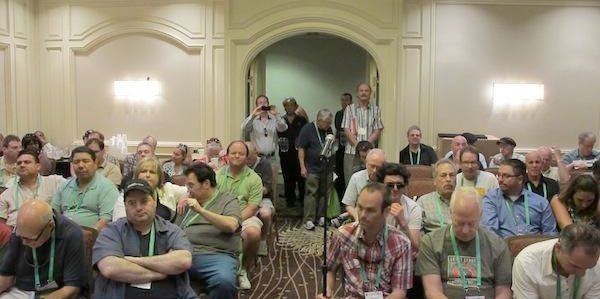T.H.E. Show Newport Beach Day 3
The 2014 edition of the Newport Show is over. Sunday, the final day, was much busier than most final days of a show. The traffic was very good. I managed to sell almost as much as on Sunday as the previous day, in spite of the fact that I attended a couple of seminars. I can’t guess at the total number of attendees but the Newport is among the best attended shows in North America.
I continued to show off the HTC M8 Harman Kardon edition phone to great effect. In fact, I set it up so that attendees could compare the fidelity of various sound formats. I think it’s important listeners have the opportunity to hear the same file as a typical MP3 file, a CD quality 44.1 kHz/16-bit version, as a 96 kHz/24-bit and finally processed through Headphones[xi]™ to get the sound out of your head. I’ve prepared Laurence Juber’s award-winning “Mosaic” track in each of these formats and posted them on the FTP site. Take a listen and see what you think.
One of my readers wrote and said the following about the different versions.
“Thanks for the access. I downloaded and compared the 16/44.1 & 24/96 Laurence Jaber (SP) – Mosaic, and was surprised to hear such an obvious difference. It was strange for two reasons. First, my NAD C316BEE integrated amplifier is only rated at 20-20k, so I wasn’t sure that any difference would be heard from a high res file. The second was related to what difference I heard. I did notice a more relaxed and natural sound overall to the high res file, but one thing I didn’t expect to hear was almost an increased level of proximity effect in the beginning passage with the guitar. It sounded almost like the mic was pushed in a few inches. Since these are the same recording that obviously isn’t the case, but I can’t explain why I would hear this.”
In the afternoon, I went over to the seminar room and listened to Cookie Marenco of Blue Coast Records and her panel on “Provenance: The Six Degrees of Degradation”. She was joined by Andreas Koch of Playback Designs and Bruce Brown of Puget Sound Studios. Despite some early technical problems with her PowerPoint presentation not connecting to the projector, Cookie explained the notion of provenance as it pertains to audio recording and the origins of the various production processes. Then she outlined the six places that sound degradation can occur in the making of a record.
According to Cookie, these are the six stages where audio can take a hit.
1. The Recording
2. The Mix
3. Mastering
4. Authoring or Conversion and the Entry of Metadata
5. Remastering, Manufacturing and Distribution
6. The Consumer Experience – Playback System
She went through each one of these areas and discussed how various choices made by engineers and producers affect the fidelity of the final listening experience.
There are lot more factors than just these 6 that affect the ultimate recording quality. I could come up with more than a dozen just in the “Recording” stage. For example, the venue, the microphones, stereo vs. mono miking, microphone placement, cables, mic preamplifiers, ADCs, recording format etc. Every one of these items can affect or “degrade” the fidelity of a recording.
The last thing I did on Sunday was to walk across into some of the demo rooms that were close by. The playback system directly across the hall from the Marketplace II/Irvine II room, where I was, played a very strange collection of decidedly standard resolution tracks. When I entered the room, Pink Floyd was playing…and it was so loud, harsh, bright and distorted that I had to leave.
Down the hall were MBL and Boulder. I saw Rich Maez from Boulder and he told me that the two monoblock 2050 amps playing the Metallica track through DynAudio speakers (it was time for requests) sell for $49,000 each. Again, loud and without much to say…
So that was the day. I packed up my equipment and products and drove back home. Time to start thinking about traveling to Boston for a graduation ceremony at MIT. Later.


Rocket science…or simply “starting with and end in mind”? It seems as though the six points made in her .ppt presentation (functional or process areas) should be automatic for all that work in the discipline…and even informed consumers of the product. Apparently not.
“Obvious Difference”
I have not listened to the two versions of Mosaic (44.1/16 and 96/24), however, I did recently take the 96/24 version of Benny’s Bounce (by Juber) and convert it to 44.1/16 using Pure Music’s “Mastering Quality Sample Rate Converter”. I would describe the difference I heard as subtle (when using my Sennheiser hd600) and as less than subtle [maybe non existent] when using my B&W 804D. Possibly the converter you used for the two formats is flawed?
I do believe there is a difference (even though they both sound great). I, for the sake of disclosure, can hear a difference between my USB cable that has the power line in place and the USB cable that has it removed — so I’m probably full of it!
Dr. Mark,
Your comments about the HTC M8 Harman Kardon edition phone are very interesting. You mentioned that you’ve set up demo tracks on an FTP site. I’d be very interested in listening to your demo if you wouldn’t mind sharing the link.
Thanks,
Doug
Click on the FREE HD-Audio tracks banner on the site.